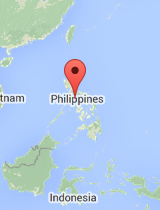Medical Summary
The health risk information presented here is summarized from Shoreland Travax®, a decision-support tool used by health care providers to perform a detailed health risk analysis based on specific locations, individual travel styles, and traveler risk behaviors. Travax provides practitioners current, independently researched malaria risk and prevention recommendations in a map-based format that goes beyond the annual WHO and US CDC statements included here. Not included here are current reports from Travax of disease outbreaks or environmental events that may pose elevated risks to travelers’ health and safety. The Providers section of this site offers a directory of health care providers who utilize Shoreland Travax for travel health counseling. Learn more about the detailed reports and maps available from these practitioners (includes links to samples).
General Information
The Philippines is a developing nation classified as lower middle income. Located in Southeast Asia in the Pacific Ocean and consisting of more than 7,000 islands, the climate classifications range from humid equatorial (no dry season) in the south to humid equatorial (long dry season) in the north.
Vaccinations
Routine vaccinations are essential due to a persistent global rise of vaccine-preventable diseases (especially markedly high rates of diphtheria, pertussis, and measles). Prior to travel, travelers should be up-to-date with the age-appropriate routine vaccinations recommended by their home country, which may include: COVID-19; H. influenzae type B (Hib); hepatitis A; hepatitis B; herpes zoster; human papillomavirus; influenza; measles, mumps, rubella (a single early dose is recommended for travelers aged 6-11 months); meningococcal; pneumococcal; polio; rotavirus; tetanus, diphtheria, pertussis (Tdap preferred; consider an early pertussis booster for high-risk travelers); varicella.
Yellow Fever
See also: Library article for Yellow Fever
Although yellow fever does not occur in Philippines, an official yellow fever vaccination certificate may be required depending on your itinerary.
- Requirement: A certificate proving yellow fever vaccination is required for travelers aged ≥ 9 months coming from countries with risk of YF transmission. This also applies to airport transit stops (no exit through immigration checkpoint) longer than 12 hours in risk countries.
Other Vaccines
Depending on your itinerary, your personal risk factors, and the length of your visit, your health care provider may offer you vaccination against chikungunya, cholera, dengue, Japanese encephalitis, mpox, rabies, typhoid fever, or a one time polio booster if you haven't previously received one for travel.
Malaria
See also: Library article for Malaria
The following is current information as reported by the World Health Organization (WHO) and the US Centers for Disease Control (CDC):
WHO—International Travel and Health (current online update, Country List)
(2022) The risk of malaria transmission is very limited.Malaria risk exists throughout the year in 9 remaining endemic provinces (Palawan, Sultan Kudarat, Davao del norte, Maguindanao, Sulu, Mindoro occidental, Tawi-tawi, Cagayan Valley, and Davao City).
- Recommended prevention in risk areas: A - Very limited risk of malaria transmission. Mosquito bite prevention only.
WHO Country List footnote: When available, the date of the most recent update or confirmation is indicated in parentheses in the country list. If no accurate date is indicated, the most recent update or confirmation was provided prior to 2013.
CDC—Health Information for International Travel (current online edition)
Transmission areas
- Province of Palawan and the Mindanao Island group
- No malaria transmission in metropolitan Manila (the capital) or other urban areas
Drug resistance1
- Chloroquine
Species
- P. falciparum (85%)
- P. vivax (15%)
- P. knowlesi6, P. malariae, and P. ovale (rare)
Recommended chemoprophylaxis
- Atovaquone-proguanil, doxycycline, mefloquine, tafenoquine2
1 Refers to P. falciparum malaria, unless otherwise noted.
2 Tafenoquine can cause potentially life-threatening hemolysis in people with glucose-6-phosphate-dehydrogenase (G6PD) deficiency. Test for G6PD deficiency with a quantitative laboratory test before prescribing tafenoquine to patients.
6 P. knowlesi is a malaria species with a simian (macaque) host. Human cases have been reported from most countries in Southwest Asia and are associated with activities in forest or forest-fringe areas. P. knowlesi has no known resistance to antimalarials.
Other Concerns
Travelers' Diarrhea
See also: Library article for Travelers' Diarrhea
Moderate risk exists throughout the country, including in deluxe accommodations. Community sanitation and food safety measures may be inadequate. Some itineraries (e.g., remote destinations, austere accommodations) and activities (e.g., ecotourism, eating street or local-market food) further increase risk.
Travelers should observe food and beverage precautions, which reduce the likelihood of illness.
Travelers should carry loperamide for self-treatment of diarrhea and, if risk is moderate to high, an antibiotic to add if diarrhea is severe. Consult a knowledgeable health care provider regarding which antibiotic is appropriate for you and most effective for your destination.
Other Food-Borne Illnesses
Precautions to prevent brucellosis, seafood poisoning may be needed.
Insect- and Arthropod-Borne Diseases
West Nile virus, Zika may pose a risk. Personal protective measures are important.
Other Disease and Health Risks
Additional concerns include air pollution, anthrax disease, enteroviruses, helminths, leptospirosis, marine hazards, melioidosis, schistosomiasis, sexually transmitted infections, snakebites, tuberculosis.
Safety and Security
See also: Library article for Safety and Security
Key Safety Risks
- Road conditions
- Public transportation
- Maritime safety
- Petty crime
- Food and beverage spiking
- Scams
- Natural disasters
Key Security Threats
- Unresolved conflict with breakaway region
- Terrorist attacks by domestic and/or transnational groups, which may target foreign nationals or airports
- Explosions in public places
- Violent crime
- Kidnapping/hostage taking, which may target foreign nationals
- Random acts of armed violence
- Piracy
Emergency Contacts
The national emergency number is 911.

